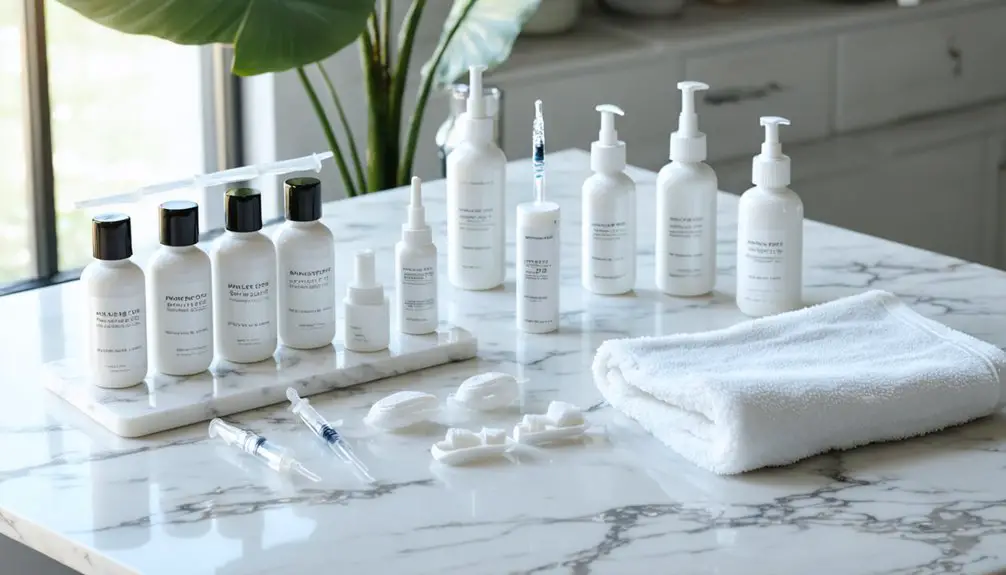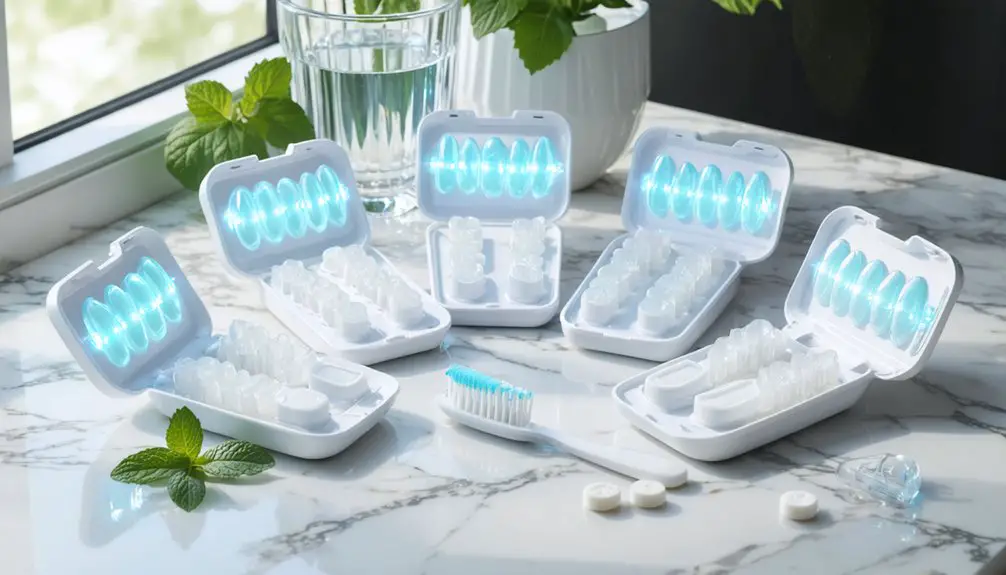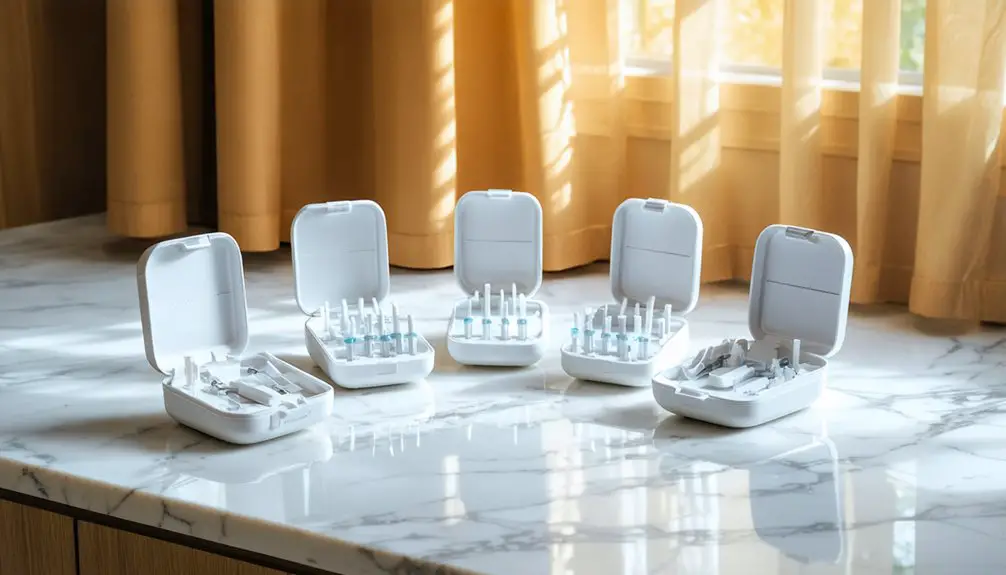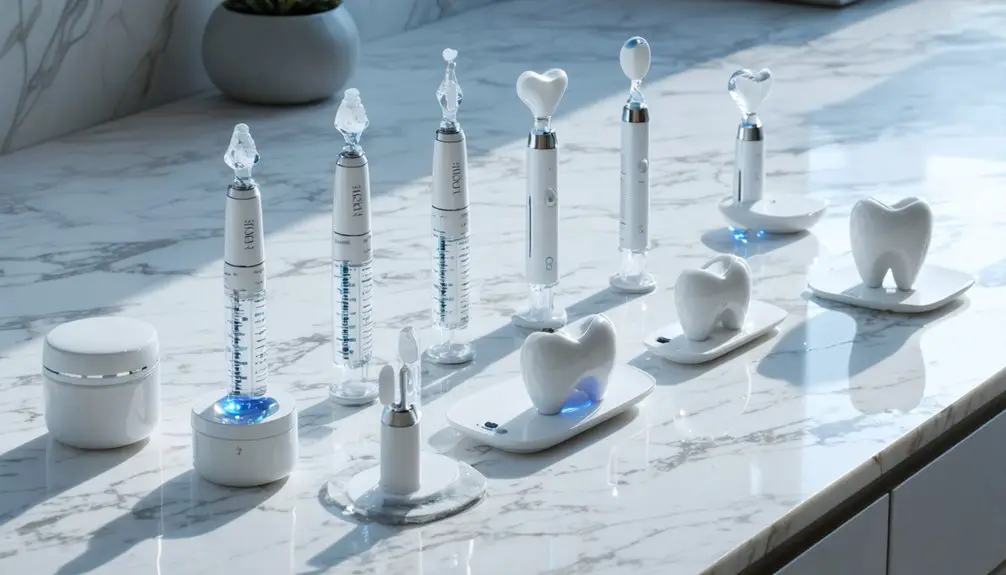For sensitive gums, choose whitening kits with low-concentration peroxide formulas (under 6%) and desensitizing agents like potassium nitrate or fluoride. SmileBe Deluxe Kit with PAP+ technology and Burst Teeth Whitening Strips offer gentle yet effective results, while custom-fitted trays prevent gel leakage onto gum tissue. Monitor for irritation and use desensitizing toothpaste during treatment. Professional supervision maximizes safety and results, but several at-home options provide controlled whitening with minimal sensitivity risks.
Key Takeaways
- SmileBe Deluxe Whitening Kit features PAP+ technology that safely whitens teeth without causing sensitivity or damaging enamel.
- Look for products containing potassium nitrate and fluoride as desensitizing agents that block nerve signals during whitening.
- Custom-fitted trays, like those in PearlBright Pro, prevent gel leakage onto gums and minimize irritation during treatment.
- Choose whitening formulas with hydrogen peroxide concentrations under 6% to reduce sensitivity while maintaining effectiveness.
- Crest 3D White Whitestrips Gentle Routine offers an affordable option ($20-$45) specifically designed for sensitive teeth and gums.
Understanding Gum Sensitivity and Teeth Whitening
The physiological impact of teeth whitening on gum sensitivity stems from specific chemical and mechanical interactions between bleaching agents and oral tissues.
When you undergo whitening methods, hydrogen peroxide or carbamide peroxide penetrates your enamel, potentially exposing dentinal microtubules that connect to nerve endings. This process can trigger temporary discomfort, especially if you have thin enamel or pre-existing gum health issues. Using desensitizing toothpaste immediately after whitening treatments can help minimize sensitivity by blocking nerve pathways.
Your gums may become irritated when whitening gels make direct contact with soft tissues, causing inflammation and sensitivity. Professional supervision during whitening treatments helps ensure proper application and reduces the risk of adverse effects.
The exposure of dentinal tubules to whitening agents can lead to sharp, temporary pain when consuming hot, cold, or sweet items.
Whitening treatments can trigger tooth sensitivity by exposing dentinal tubules, making your teeth temporarily reactive to temperature and sweet stimuli.
Understanding these mechanisms is vital because it helps you choose appropriate whitening options and take necessary precautions to protect your oral tissues during treatment.
Top-Rated Whitening Kits Safe for Sensitive Gums
Several clinically proven whitening kits now offer effective bleaching while prioritizing gum comfort and minimal sensitivity.
The SmileBe Deluxe Whitening Kit leads with its PAP+ Whitening Powder technology, delivering rapid stain oxidation without compromising enamel integrity. The high user rating of 4.95 from reviews demonstrates strong customer satisfaction with the product.
For those seeking shorter treatment times, Burst Teeth Whitening Strips provide notable results in just 15 minutes daily while maintaining excellent gum comfort. These strips can whiten teeth by 2 shades in one week, making them an efficient choice for those with sensitive gums.
PearlBright Pro’s system combines professional-grade effectiveness with gentle formulation, utilizing a custom-fit tray design that protects gum tissue.
While Walgreens Extreme Whitening Wraps offer an economical solution with enhanced contour fit, you’ll need to monitor teeth sensitivity closely.
The CVS Platinum Kit delivers powerful results with its 25% carbamide peroxide concentration but requires careful adherence to usage guidelines to prevent sensitivity issues.
Key Ingredients to Look for in Sensitivity-Friendly Products
When selecting a whitening kit for sensitive gums, you’ll want to focus on products containing potassium nitrate and fluoride as primary desensitizing agents, which help block nerve signals and strengthen enamel during treatment. Custom-fitted trays can provide optimal protection against sensitivity during the whitening process.
Natural ingredients like coconut oil and sage extract can provide gentle whitening while soothing gum tissue, offering an alternative to traditional peroxide-based formulas. Using professional grade trays that fit properly helps prevent whitening gel from leaking onto gums and causing irritation.
For ideal results with minimal sensitivity, look for kits featuring low concentrations of hydrogen peroxide (under 6%) or carbamide peroxide combined with remineralizing agents such as calcium phosphate.
Desensitizing Agents That Work
Understanding effective desensitizing agents in teeth whitening products requires knowledge of key active ingredients that scientifically reduce sensitivity through distinct mechanisms.
Potassium nitrate benefits include calming pulpal nerves and decreasing pain sensation during whitening, particularly at 5% concentrations in professional-strength formulations. Clinical evidence shows that hydrogen peroxide concentration directly correlates with increased tooth sensitivity during treatment. Professional supervision from a licensed dentist helps ensure optimal ingredient concentrations for your specific sensitivity level.
You’ll find strontium compounds effectiveness demonstrated through their dual action: precipitating insoluble metals to block dentin tubules while depolarizing nerves.
Stannous fluoride creates a protective layer of insoluble salts while offering antimicrobial properties, though you’ll need to watch for potential staining.
Arginine, especially when combined with calcium compounds, physically occludes tubules for immediate relief.
When selecting products, consider that higher peroxide concentrations increase sensitivity risk, making these desensitizing agents essential for successful treatment outcomes.
Natural vs. Chemical Ingredients
Building on the role of desensitizing agents, choosing between natural and chemical ingredients marks a key decision point for sensitive teeth whitening.
When selecting sensitivity-friendly products, you’ll find that natural ingredients often provide gentler whitening effects while minimizing tissue irritation. Clinical evidence supports the efficacy of specific natural compounds over harsh chemicals for sensitive gums. Professional treatments have shown that gradual whitening techniques are most effective for minimizing discomfort while achieving desired results. Dental experts recommend using a diluted solution of hydrogen peroxide to prevent gum irritation while still maintaining whitening effectiveness.
- Baking soda combined with low-concentration hydrogen peroxide (1-3%) offers controlled whitening without aggressive chemical action.
- Coconut oil’s lauric acid provides antimicrobial benefits while protecting enamel integrity.
- Natural anti-inflammatory agents like aloe vera and chamomile extract support gum health during whitening.
For best results, avoid products containing sodium lauryl sulfate, high-concentration peroxides, or strong abrasives, as these chemical ingredients can exacerbate sensitivity and compromise gum tissue health.
Low-Peroxide Formula Benefits
Low-peroxide formulas represent a significant advancement in teeth whitening technology for sensitive users, offering targeted stain removal while minimizing gum irritation.
These formulations typically contain protective agents like allantoin and strontium chloride hexahydrate, which actively reduce sensitivity while supporting ideal gum health during treatment.
Among the non-peroxide advantages, you’ll find gentle whitening ingredients such as calcium carbonate and pentasodium triphosphate that effectively break down surface stains without harsh oxidation.
When selecting a whitening system, look for concentrations of hydrogen peroxide no greater than 3.5% in over-the-counter products to guarantee safety.
For enhanced comfort, formulas containing menthol and Mentha Viridis leaf oil provide soothing effects during treatment.
These ingredients allow for more frequent use while maintaining the integrity of your enamel and supporting long-term gum health.
Professional vs. At-Home Whitening Options

When deciding between professional and at-home teeth whitening options, it’s crucial to evaluate their distinct approaches and outcomes.
Professional whitening delivers rapid results under dental supervision, utilizing higher-concentration peroxide formulas that can brighten teeth up to 8 shades in a single session.
At-home kits offer a more gradual approach with lower-strength formulations designed for safety and convenience.
Key considerations for sensitive gums include:
- Professional treatments provide customized protective measures and expert monitoring to minimize gum irritation.
- At-home kits require consistent application over weeks, with results varying based on proper technique.
- Custom-fitted trays from dental professionals offer superior gum protection compared to generic at-home options.
Your choice should align with your sensitivity concerns, desired timeline, and budget constraints.
Natural Alternatives for Gentle Teeth Whitening
For individuals with sensitive gums seeking teeth whitening solutions, natural alternatives offer gentler approaches that minimize irritation while gradually improving tooth brightness.
You’ll find several gentle methods particularly suitable for sensitive gums, including oil pulling with coconut oil and a carefully formulated baking soda-hydrogen peroxide paste.
When using the paste, mix one tablespoon of baking soda with two tablespoons of hydrogen peroxide and brush for 1-2 minutes twice daily.
For oil pulling, swish coconut oil for 15-20 minutes daily to reduce stain-causing bacteria.
Support your natural whitening efforts by avoiding staining foods and incorporating crunchy vegetables into your diet.
These methods, while slower-acting than chemical treatments, protect your enamel while working toward a brighter smile without aggravating sensitive gums.
Safety Guidelines and Best Practices

Since teeth whitening carries potential risks for sensitive gums, following strict safety protocols becomes crucial for successful treatment outcomes.
To minimize teeth sensitivity and protect your oral health, you’ll need to implement professional-grade precautions during your whitening regimen.
- Use custom-fitted trays that prevent gel leakage onto gum tissues, and maintain meticulous oral hygiene throughout the whitening process.
- Follow manufacturer guidelines precisely for application duration and frequency, discontinuing use if you experience severe discomfort.
- Apply desensitizing agents post-treatment and avoid temperature extremes in foods and beverages for 24-48 hours.
These evidence-based practices help safeguard your gum health while achieving ideal whitening results.
Remember to schedule regular dental check-ups to monitor your enamel integrity and ascertain your whitening protocol remains appropriate for your sensitivity level.
How to Prevent Gum Irritation During Whitening
To effectively minimize gum irritation during teeth whitening procedures, implementing a thorough preventive approach becomes essential for maintaining oral tissue health.
While common home remedies and whitening myths suggest quick fixes, professional-grade protection requires strategic preparation. Start by applying desensitizing agents containing potassium nitrate or fluoride before treatment, and create a protective barrier using specialized gum shields or petroleum jelly along your gum line.
Don’t exceed recommended treatment durations, and space your whitening sessions appropriately to allow tissue recovery. If you experience sensitivity, immediately discontinue use and switch to gentle oral care products.
Consider consulting your dentist for custom-fitted trays and personalized whitening protocols, as these greatly reduce the risk of chemical exposure to your gums compared to over-the-counter alternatives.
Comparing Popular Sensitive-Friendly Whitening Brands

When selecting teeth whitening products for sensitive gums, understanding the formulation differences between leading brands becomes paramount for ideal results.
Various teeth discoloration causes require different treatment approaches, influencing whitening frequency recommendations based on sensitivity levels and desired outcomes.
- Crest 3D White Whitestrips for Sensitive Teeth delivers controlled peroxide concentrations through a 30-day protocol, making it suitable for daily use while minimizing gum irritation.
- Snow Teeth Whitening Kit combines LED technology with sensitivity-conscious formulations, accelerating results while protecting sensitive tissue through shorter contact periods.
- Oral Essentials Lumineux offers a peroxide-free alternative utilizing natural ingredients like coconut oil, ideal for patients with extreme sensitivity who prefer gradual whitening progression.
These evidence-based options provide varying approaches to achieving whiter teeth while prioritizing gum health and comfort.
Signs You Should Stop or Pause Treatment
If you’re experiencing persistent gum redness, swelling, or bleeding during whitening treatment, these physical warning signs indicate the need to immediately pause your regimen.
Tooth sensitivity lasting beyond several days, especially when triggered by temperature changes or sweet stimuli, suggests potential enamel compromise requiring treatment cessation.
You should promptly consult your dental professional if you develop any signs of allergic response, including oral tissue inflammation or ulceration, or if discomfort persists for more than a week after stopping treatment.
Physical Warning Signs
Understanding the physical warning signs during teeth whitening treatment is essential for preventing potential tissue damage and complications. When monitoring your gum health during treatment, watch for indicators that signal the need to adjust your treatment frequency or pause entirely.
Key physical warning signs include:
- Persistent redness or swelling around your gum margins that lasts beyond a few hours
- White patches or tissue peeling, indicating potential chemical burns from peroxide exposure
- Bleeding or severe gum irritation during or after whitening application
If you experience these symptoms, immediately discontinue treatment and allow your gum tissue to recover.
Using poorly fitted trays or applying whitening gel too close to your gum line greatly increases your risk of tissue damage.
Consider consulting your dental professional to evaluate your whitening routine and recommend appropriate modifications.
When to Contact Professionals
Recognizing the difference between normal sensitivity and serious complications can determine the success of your teeth whitening treatment. Despite common whitening myths, not all discomfort requires professional intervention. However, you’ll need to contact your dentist if you experience persistent sensitivity lasting beyond 48 hours, intense pain, or burning sensations.
Contrary to sensitivity misconceptions, certain symptoms demand immediate professional attention: swelling or redness around the gums, blistering, breathing difficulties, or allergic reactions.
You should also pause treatment and seek evaluation if you notice bleeding gums, visible enamel erosion, or uneven whitening results. Watch for structural complications like cracking restorations or increased tooth mobility.
If you’re uncertain about proper product use or experience persistent mucosal irritation, consult your dental professional for guidance.
Cost-Effective Solutions for Sensitive Teeth Whitening
Three affordable whitening solutions have emerged for individuals with sensitive teeth seeking cost-effective alternatives to professional treatments.
Contrary to common whitening myths and sensitivity myths, you can achieve effective results without spending hundreds on professional procedures. Today’s at-home options combine gentle formulations with proven whitening agents.
- Crest 3D White Whitestrips Gentle Routine ($20-$45) uses low-peroxide formulas with potassium nitrate to minimize sensitivity.
- LED-accelerated kits ($40-$100) provide enhanced stain removal over 14 days while maintaining comfort.
- Whitening pens with carbamide peroxide offer portable, gradual whitening for sensitive teeth.
When selecting your whitening solution, look for products containing fluoride and desensitizing agents.
Choose ADA-approved options and combine with sensitivity toothpaste for ideal comfort during treatment. This approach guarantees safe, effective whitening while protecting your enamel.
Frequently Asked Questions
Can I Whiten My Teeth While Wearing Braces or Dental Implants?
You shouldn’t attempt braces whitening, as it causes uneven results. While implant care allows whitening of natural teeth, implant crowns won’t change color, so discuss timing with your dentist first.
How Long Should I Wait to Whiten Teeth After Dental Work?
90% of dentists recommend waiting 7-14 days after dental work before whitening. You’ll need this dental healing period to minimize teeth sensitivity and protect new restorations for ideal whitening results.
Will Whitening Affect the Color of Existing Crowns or Veneers?
No, your crown restorations and veneers won’t change color with whitening treatments. They’re made of non-porous materials that can’t absorb bleaching agents, so proper veneer maintenance is essential for lasting aesthetics.
Does Drinking Through a Straw Prevent Teeth Staining During Whitening?
While straws reduce tooth contact with staining liquids by 60%, they won’t completely prevent staining during whitening. You’ll still benefit from straw use, but proper placement behind front teeth is essential.
Can Pregnancy or Nursing Affect Teeth Whitening Safety for Sensitive Gums?
You shouldn’t whiten teeth during pregnancy or nursing due to pregnancy effects on gum sensitivity and limited safety research. Nursing considerations include potential chemical exposure through breast milk. Consult your dentist for safer alternatives.
References
- https://smiledailey.com/teeth-whitening-for-sensitive-teeth-is-it-safe/
- https://www.goochlanddentistry.com/whats-the-best-teeth-whitener-for-sensitive-teeth/
- https://www.westriverdentalcare.com/best-teeth-whitener-for-sensitive-teeth/
- https://nhdentistrybeverlyhills.com/press/6-of-the-best-teeth-whitening-kits-in-the-drugstore/
- https://www.gentledental.com/resources/articles/teeth-whitening-products
- https://familydentistchandler.com/how-to-avoid-teeth-sensitivity-after-whitening/
- https://111dental.com/can-teeth-whitening-damage-gums-how-to-whiten-safely-in-bixby-ok/
- https://www.scottgreenhalghdds.com/blog/10-tips-for-dealing-with-sensitivity-after-teeth-whitening
- https://www.wauwatosadentists.com/does-teeth-whitening-cause-tooth-sensitivity/
- https://crest.com/en-us/oral-care-tips/teeth-sensitivity/teeth-whitening-sensitivity-causes-how-to-avoid-it



